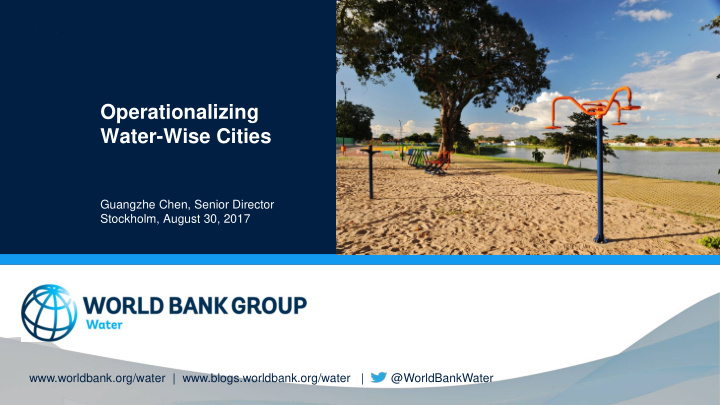



Operationalizing Water-Wise Cities Guangzhe Chen, Senior Director Stockholm, August 30, 2017 www.worldbank.org/water | www.blogs.worldbank.org/water | @WorldBankWater
Operationalizing Water-Wise Cities Integrated Urban Water Management Concept Principles Benefits Implementation Examples Lessons
Integrated Urban Water Management – IUWM Holistic strategic planning that takes a landscape approach and manages competing water users at the level of the watershed, recognizing the needs of the city, as well as those of upstream and downstream users Graphic Source: http://www.neorsd.org/images/RestoredUrbanWatershed_large.jpg 2
Key Principles of Integrated Urban Water Management Integration across the water cycle • Wastewater and stormwater: a resource • Water cycle as one system • Matching water quality with intended use Integration of urban and water systems • Pursuing economic efficiency, social equity and environmental sustainability • Integrating water resources, land-use planning and key urban services (e.g., solid waste, housing, transport) Integrated planning and implementation • Source-http://www.ewater.org.au/uploads/images/source-composite-web.jpg Stakeholder involvement instead of top-down • Multidisciplinary planning teams 3
Benefits of Integrated Urban Water Management Before Costs savings through coordination & After synergies, promoting alternative technologies & approaches Leveraging complementary financing different sectors; different levels of government, bringing in alternative financing (private sector, payment for environmental services) Improved living conditions, quality of life, economic stimulation, etc., through urban transformation, including green & cultural aspects 4
Fast Growing Cities can ‘leap - frog’ to Water Wise Cities … … avoiding mistakes of most developed cities and securing economic benefits earlier 1 2 3 4 5 6 1 2 3 4 5 6 WATER WATER WATER WATER SEWERAGE DRAINAGE WATER WATER WATER WATER SUPPLY WAYS CYCLE WISE SEWERAGE DRAINAGE SUPPLY WISE WAYS CYCLE Social Source: Brown et al (2009), and Wong and Brown (2009) Limits on Intergenerational Access & Public Flood Intergenerational Public health Flood Social amenity, Access & amenity, Limits on natural natural equity, resilience security protection health equity, resilience protection environmental protection security environmental resources to climate resources protection to climate change protection 5 protection change
Implementing Integrated Urban Water Management After Before Sustainable Solutions • Water Resources Management • Water Supply & Sanitation • Stormwater … and beyond water … • Urban Planning, Land use • Solid waste • Environment, recreational • Housing • Regulations, policies, non-structural measures (e.g., flood zoning, permits, etc.) 6
Key Elements Main Drivers: Urban Planning and Land Use as well as… For the improvement of quality Cross-Sector of life and the environment Tailored Solutions Coordinated Execution Integrated Participatory …stakeholder and Planning community engagement 7
Process Range of players and sectors involved for… …an integrated solution tailored to local context and dynamics 8
Example – Brazil: Teresina Two phases of integrated interventions focused in Lagoas do Norte, an environmental and socially vulnerable area of the city (13 km 2 and 100,000 inhabitants) Drainage, roadways and access ways Parks, leisure and cultural spaces Public service improvement: sanitation, schools, health posts Housing Municipal planning and modernization Citizen engagement Crime and violence prevention Local Economic Development 9
Examples – Ethiopia: Addis Ababa Surface and Drainage, Quality of Housing Groundwater Pollution Roadways and Access Ways 3.35 million people – expected to grow by 38% by 2030 600,000 m 3 water production vs. 1.3 million m 3 current demand 7% of households connected to sewers Upstream clean resources gradually deteriorates from domestic, institutional and industrial untreated waste disposal 10
Lessons • Integrated interventions are complex and should be part of a long process developed step-by-step, which requires vision , persistence and commitment • Integrated planning and implementation takes time and resources ($$ and people) … • … but it pays off: integrating actions and measures in the urban space is more efficient to achieve economic, social and environmental gains • Institutional strengthening and capacity building are an essential part of the process to move from planning to actions • Active stakeholder and community engagement is vital to success 11
Lessons • Geographically-focused interventions (basin, sub-basin) tend to work best • Land use is a key driver; the earlier you integrate the planning process, the bigger the pay-off: –At the very least lower resettlement costs, but also … – Costs of storm water solutions: Development with sustainable solutions (public US$ 200 to 400 thousand/km 2 spaces solutions) Correction with detention (storage) and water US$ 2 to 3 million/km 2 quality control, avoiding flow increase Correction with channels and conduits, US$ 6 to 7 million/km 2 transferring impacts downstream 12
THANK YOU www.worldbank.org/water | www.blogs.worldbank.org/water | @WorldBankWater
Recommend
More recommend